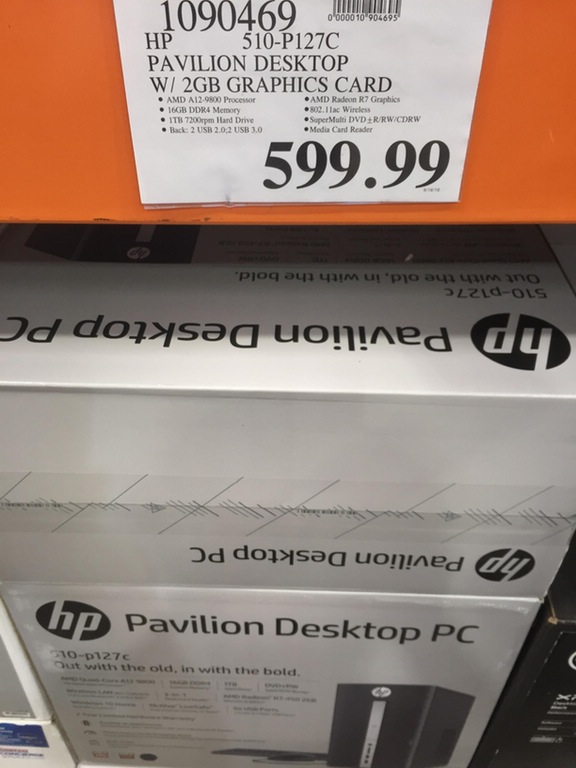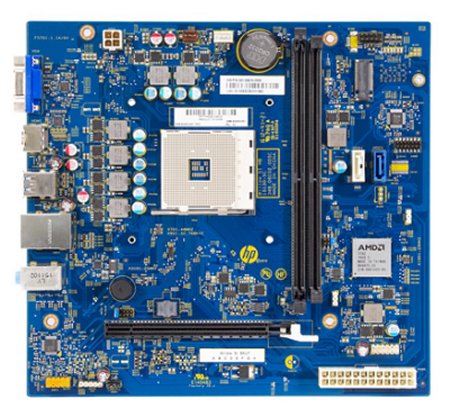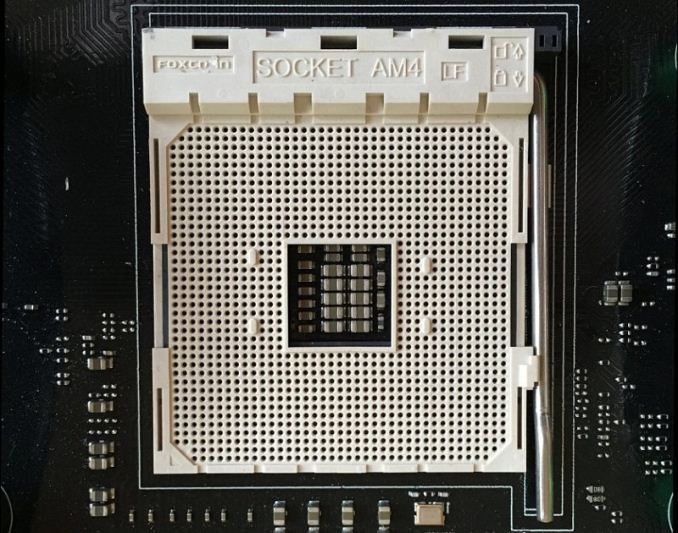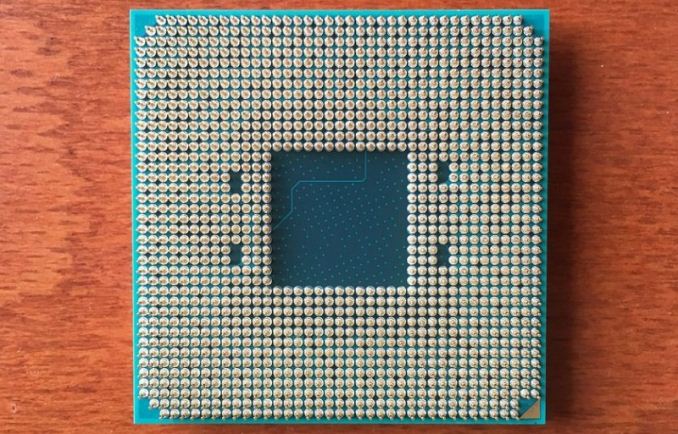AMD 7th Gen Bristol Ridge and AM4 Analysis: Up to A12-9800, B350/A320 Chipset, OEMs first, PIBs Later
by Ian Cutress on September 23, 2016 9:00 AM ESTMotherboards, Sockets, Pins and Things
As an OEM only launch, details about exact systems coming to market (and how they are designed) is providing slim pickings. With a normal retail launch, we have several motherboard manufacturers to dig our teeth into when asking questions, however our relationships with the major OEMs such as HP, Dell or Lenovo are quite different and typically more product focused and less engineering. We’ve not seen any real Bristol Ridge related announcements on OEM systems coming into the market, but some do exist. Reddit user starlightmica saw this HP Pavilion 510-p127c in Costco this week:
$600 gets an A12-9800, 16GB of DDR4, a 1TB mechanical drive, an additional R7 2GB graphics card, 802.11ac WiFi, a DVDRW drive, and a smattering of USB ports (but no USB 3.1, which is interesting).
We reached out to HP, as this system was listed online with the blurriest of motherboard images.
This is a ‘Willow’ motherboard, and we can see the AM4 socket in the middle. Contrary to previous platforms, it is worth noting that the socket mounting holes are significantly more ‘square’ than previous motherboard designs. However, when we discussed the images of the South Korean overclocker near the beginning of this article, it looked like he was using a standard AMD Wraith cooler, which might suggest that this square mounting hole situation might just be HP designing the motherboard.
The board clearly has six phases as part of the power delivery, plus an additional phase for the memory. I would assume that since the system has dual channel support, HP has developed the two memory slots as having dual channel capability, and the abundance of traces from the APU seems to suggest that as well.
To the right of the DRAM slots seems to be a PCIe x1 slot, which is where I assume the WiFi module is held. Below this slot are two of the system SATA ports, followed by what looks like a chipset with a big AMD logo on it and then the 24-pin power connector.
The motherboard has a full PCIe 3.0 x16 sized slot, although as we discussed before, this will be limited to PCIe 3.0 x8 due to the design of the processor. To the left of this is clearly a Realtek audio codec, and judging by the 2.1 support on the rear panel, this is most likely an ALC269 or some other low-end codec. It is hard to tell where the network controller is here without the high-resolution image, but just above and to the left of the speaker looks like a small IC which looks similar to Realtek’s low-end solutions. Typically Realtek offers a deal when audio+networking chips are used in the same system, so I suspect that is what is happening here. Above this are our USB ports, an HDMI output, and a VGA port which must be using a DP-to-VGA IC onboard.
We have closer up images of the socket, thanks to the Hungarian website hwsw:
This looks like the standard ZIF socket we’ve come to love/loathe from AMD (I doubt there’s a way that keeps everyone happy anyway), and others have counted 1331 holes which may/may not do things.
The rear of the CPU, also from hwsw, is what we would expect given the socket layout. It does mean that AMD is stuck at this level of connectivity, to anyone wishing for a quad-channel AMD platform suitable for consumers will have to wait until a future platform. It’s also worth noting that this looks like a similar size to when AMD CEO Lisa Su held up a Zen chip for the press back at the Zen announcements in August.
What Happens Now
Aside from spotting systems like the HP in Costco, no doubt a number of media outlets (us included) are trying to get hold of a number of the APUs for official reviews. As mentioned previously, that A12-9800 looks like an exciting all round part. We are working with AMD to secure the platform and the APUs for testing.
AMD has told us that Bristol Ridge APUs are designed to have price parity with the current Kaveri Refresh/Godavari models, however exact configurations of APUs and coolers, as well as a timeframe for the motherboard manufacturers to come out with their designs, is still to be decided.
I suspect that AMD will wait until closer to the Zen launch window to put Bristol Ridge on the shelves. Attacking the market with a new platform that goes from the high-end desktop through to all but the cheapest systems would mean a concerted effort to gain market share and recognition for catering to the performance needs of as many users as possible all at once. AMD has promised that Zen will trickle down the stack, however as we were told regarding their server and laptop plans later in 2017, that will mostly likely occur later in the year also.
If you’ve read through this piece, or merely skipped to the last page for the conclusions, here’s the take away from the Bristol Ridge for desktop launch:
- OEMs first, DIY builds later
- The A12 at 65W has better specifications than the best previous generation A10 at 95W
- Even at 65W, there is +30% frequency on the integrated graphics for the A12-9800
- The chipsets support USB 3.1 (10 Gbps) natively, but Type-C requires a small additional chip
- Bristol Ridge is more like an SoC, the chipset is entirely optional
- There are so many fun things you can do with PCIe and switches
- We expect the retail APUs to be price drop-ins for current APUs
- We’re trying to get these APUs for review. Stay tuned.





















122 Comments
View All Comments
jardows2 - Friday, September 23, 2016 - link
Really looking forward to some actual benchmarks. I really am itching to build a new office computer, and right now, the i3-6100 is the only realistic chip, since I won't be doing much gaming on the system. If the new A12 and A10 can even come close to matching the i3 in CPU tasks, I'd be more than happy to snag that up, as the graphics will be nice, and the upgradability to Zen later if that processor pans out.Danvelopment - Saturday, September 24, 2016 - link
I'm writing an article on that at the moment (different site built around the economics of modern tech). Conclusion is unless you need specific Skylake tech on a desktop (m.2, DDR4, ECC, IGP, SGX, MPX or AVX2), get an Ivy Bridge i5/i7. Ex-lease Ivy machines are pretty much being sold for pennies these days (less than a new Pentium machine) and a quad Ivy i5/i7 will almost always demolish a Skylake i3 on the CPU side.Use the leftover cash for a couple SSDs and beer.
serendip - Saturday, September 24, 2016 - link
And so comes the end of the desktop computer, as people refurbish old computers and use them for years instead of buying new ones every year. That Ivy i5 system paired with lots of cheap RAM and a cheap SATA SSD would be more than fast enough for office tasks for years to come.Could be good for AMD though. They could make good-enough APUs for mainstream usage at a price point Intel can't touch. It's a race to the bottom and AMD could conceivably win.
LordanSS - Saturday, September 24, 2016 - link
Still rocking my 3770k.Skylake wasn't a good enough performance bump for my use cases, considering platform price. Kaby Lake has no IPC boost, and who knows when Cannonlake will arrive.
Waiting on Zen to arrive so I can take a look at benchmarks. Even if it's "slower" than Skylake, if the platform cost is right it would be a quite viable option.
Danvelopment - Sunday, September 25, 2016 - link
Precisely, I just overclocked my 2500K to 4.5GHz the other day and it will definitely last me until Intel gets its act together and puts a focus on performance improvements again.If AMD were competitive, Intel would probably be pushing a lot more performance on successive generations. Instead they're cashing in by shrinking dies and moving more components on die, while only incrementally improving performance.
So really it's a good thing, suddenly competing with the secondhand market will hopefully see a large performance boost in future generations.
patrickjp93 - Tuesday, September 27, 2016 - link
@Danvelopment Please take a look at Agner Fog's x86 instruction latency tables. Intel can't squeeze blood from a rock and make instructions take less than 1 cycle. No one can.patrickjp93 - Tuesday, September 27, 2016 - link
Continuing from the above, that's why SIMD and MIMD instructions were created.Danvelopment - Tuesday, September 27, 2016 - link
So you're saying we've hit the limit for processor performance and there's nothing new anyone can do?I find that hard to believe, especially as innovation is not required to increase performance, hell if they were desperate they could bring i3 to a quad minimum and flop four more cores into 5 and 7 and call it a day. It's not innovation but it's a significant increase in performance potential.
Instead we've gone from a 216mm2 die to a 122mm2 die.
If it were neck and neck, Intel wouldn't look at AMD and go, "whelp, nothing we can do".
Danvelopment - Tuesday, September 27, 2016 - link
216 is Sandy Bridge and 122 is Skylake.jardows2 - Monday, September 26, 2016 - link
Where can I find these "pennies" for Ivy i5? Best I'm finding is on fleaBay for about $200 shipped. With 4GB RAM and too small of a hard drive. After I upgrade the hard drive and RAM to where I need, I have a used computer that costs only about $40 less than if I build a new i3 system. And demolish? I'm not so sure about that:http://www.anandtech.com/bench/product/1783?vs=702
Beat? Yes, but I wouldn't say demolish.